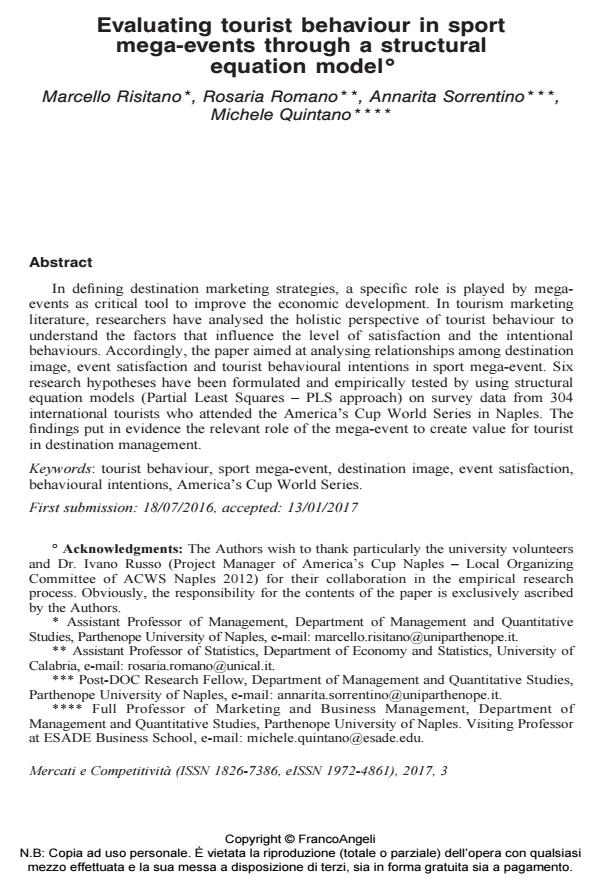Evaluating tourist behaviour in sport mega-events through a structural equation model
Journal title MERCATI & COMPETITIVITÀ
Author/s Marcello Risitano, Rosaria Romano, Annarita Sorrentino, Michele Quintano
Publishing Year 2017 Issue 2017/3
Language English Pages 26 P. 101-126 File size 134 KB
DOI 10.3280/MC2017-003007
DOI is like a bar code for intellectual property: to have more infomation
click here
Below, you can see the article first page
If you want to buy this article in PDF format, you can do it, following the instructions to buy download credits

FrancoAngeli is member of Publishers International Linking Association, Inc (PILA), a not-for-profit association which run the CrossRef service enabling links to and from online scholarly content.
In defining destination marketing strategies, a specific role is played by megaevents as critical tool to improve the economic development. In tourism marketing literature, researchers have analysed the holistic perspective of tourist behaviour to understand the factors that influence the level of satisfaction and the intentional behaviours. Accordingly, the paper aimed at analysing relationships among destination image, event satisfaction and tourist behavioural intentions in sport mega-event. Six research hypotheses have been formulated and empirically tested by using structural equation models (Partial Least Squares - PLS approach) on survey data from 304 international tourists who attended the America’s Cup World Series in Naples. The findings put in evidence the relevant role of the mega-event to create value for tourist in destination management.
Keywords: Tourist behaviour, sport mega-event, destination image, event satisfaction, behavioural intentions, America’s Cup World Series
- Qualitative Comparative Analysis (QCA): A useful methodological tool for research in the social sciences. An example from the online word-of-mouth context Ilenia Confente, Ivan Russo, in MERCATI & COMPETITIVITÀ 4/2018 pp.87
DOI: 10.3280/MC2018-004006 - Consuming Extreme Sports Francesco Raggiotto, pp.89 (ISBN:978-3-030-40126-9)
- Measuring event experience and its behavioral consequences in the context of a sports mega-event Annarita Sorrentino, Xiaoxiao Fu, Rosaria Romano, Michele Quintano, Marcello Risitano, in Journal of Hospitality and Tourism Insights /2020 pp.589
DOI: 10.1108/JHTI-03-2020-0026
Marcello Risitano, Rosaria Romano, Annarita Sorrentino, Michele Quintano, Evaluating tourist behaviour in sport mega-events through a structural equation model in "MERCATI & COMPETITIVITÀ" 3/2017, pp 101-126, DOI: 10.3280/MC2017-003007